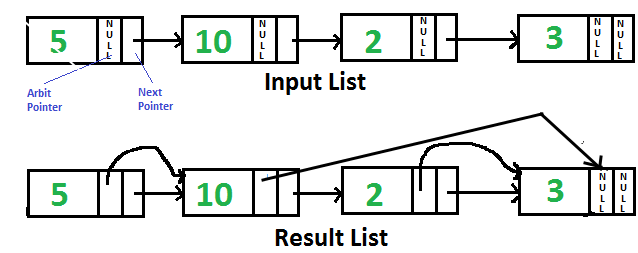用于将仲裁指针指向链接列表中的最大值右侧节点的Python程序
给定单链表,每个节点都有一个当前指向 NULL 的附加“任意”指针。我们需要将“任意”指针指向右侧链表中的最大值节点。

一个简单的解决方案是一个一个地遍历所有节点。对于每个节点,找到右侧具有最大值的节点并更改下一个指针。该解决方案的时间复杂度为 O(n 2 )。
一个有效的解决方案可以在 O(n) 时间内工作。以下是步骤。
- 反转给定的链表。
- 开始遍历链表,存储目前遇到的最大值节点。使每个节点的仲裁指向最大值。如果当前节点中的数据超过了迄今为止的max节点,则更新max。
- 反向修改链表并返回头部。
以下是上述步骤的实现。
Python
# Python Program to point arbit pointers
# to highest value on its right
# Node class
class Node:
# Constructor to initialize the
# node object
def __init__(self, data):
self.data = data
self.next = None
self.arbit = None
# Function to reverse the linked list
def reverse(head):
prev = None
current = head
next = None
while (current != None):
next = current.next
current.next = prev
prev = current
current = next
return prev
# This function populates arbit pointer
# in every node to the greatest value
# to its right.
def populateArbit(head):
# Reverse given linked list
head = reverse(head)
# Initialize pointer to maximum
# value node
max = head
# Traverse the reversed list
temp = head.next
while (temp != None):
# Connect max through arbit
# pointer
temp.arbit = max
# Update max if required
if (max.data < temp.data):
max = temp
# Move ahead in reversed list
temp = temp.next
# Reverse modified linked list and
# return head.
return reverse(head)
# Utility function to print result
# linked list
def printNextArbitPointers(node):
print("Node ",
"Next Pointer " ,
"Arbit Pointer")
while (node != None):
print(node.data ,
" ",
end = "")
if (node.next != None):
print(node.next.data ,
" ", end = "")
else :
print("None" ,
" ",end = "")
if (node.arbit != None):
print(node.arbit.data, end = "")
else :
print("None", end = "")
print("")
node = node.next
# Function to create a new node
# with given data
def newNode(data):
new_node = Node(0)
new_node.data = data
new_node.next = None
return new_node
# Driver code
head = newNode(5)
head.next = newNode(10)
head.next.next = newNode(2)
head.next.next.next = newNode(3)
head = populateArbit(head)
print("Resultant Linked List is: ")
printNextArbitPointers(head)
# This code is contributed by Arnab KunduPython3
# Python3 program to point arbit pointers
# to highest value on its right
''' Link list node '''
# Node class
class newNode:
# Constructor to initialize the
# node object
def __init__(self, data):
self.data = data
self.next = None
self.arbit = None
# This function populates arbit pointer
# in every node to the greatest value
# to its right.
maxNode = newNode(None)
def populateArbit(head):
# using static maxNode to keep track
# of maximum orbit node address on
# right side
global maxNode
# if head is null simply return the list
if (head == None):
return
''' if head.next is null it means we
reached at the last node just update
the max and maxNode '''
if (head.next == None):
maxNode = head
return
''' Calling the populateArbit to the
next node '''
populateArbit(head.next)
''' updating the arbit node of the
current node with the maximum
value on the right side '''
head.arbit = maxNode
''' if current Node value id greater
then the previous right node then
update it '''
if (head.data > maxNode.data and
maxNode.data != None ):
maxNode = head
return
# Utility function to prresult
# linked list
def printNextArbitPointers(node):
print("Node " ,
"Next Pointer " ,
"Arbit Pointer")
while (node != None):
print(node.data,
" ",
end = "")
if(node.next):
print(node.next.data,
" ",
end = "")
else:
print("NULL", " ",
end = "")
if(node.arbit):
print(node.arbit.data, end = "")
else:
print("NULL", end = "")
print()
node = node.next
# Driver code
head = newNode(5)
head.next = newNode(10)
head.next.next = newNode(2)
head.next.next.next = newNode(3)
populateArbit(head)
print("Resultant Linked List is:")
printNextArbitPointers(head)
# This code is contributed by SHUBHAMSINGH10输出:
Resultant Linked List is:
Node Next Pointer Arbit Pointer
5 10 10
10 2 3
2 3 3
3 NULL NULL递归解决方案:
我们可以递归到达最后一个节点,从最后遍历链表。递归解决方案不需要反转链表。我们还可以使用堆栈代替递归来临时保存节点。感谢 Santosh Kumar Mishra 提供此解决方案。
Python3
# Python3 program to point arbit pointers
# to highest value on its right
''' Link list node '''
# Node class
class newNode:
# Constructor to initialize the
# node object
def __init__(self, data):
self.data = data
self.next = None
self.arbit = None
# This function populates arbit pointer
# in every node to the greatest value
# to its right.
maxNode = newNode(None)
def populateArbit(head):
# using static maxNode to keep track
# of maximum orbit node address on
# right side
global maxNode
# if head is null simply return the list
if (head == None):
return
''' if head.next is null it means we
reached at the last node just update
the max and maxNode '''
if (head.next == None):
maxNode = head
return
''' Calling the populateArbit to the
next node '''
populateArbit(head.next)
''' updating the arbit node of the
current node with the maximum
value on the right side '''
head.arbit = maxNode
''' if current Node value id greater
then the previous right node then
update it '''
if (head.data > maxNode.data and
maxNode.data != None ):
maxNode = head
return
# Utility function to prresult
# linked list
def printNextArbitPointers(node):
print("Node " ,
"Next Pointer " ,
"Arbit Pointer")
while (node != None):
print(node.data,
" ",
end = "")
if(node.next):
print(node.next.data,
" ",
end = "")
else:
print("NULL", " ",
end = "")
if(node.arbit):
print(node.arbit.data, end = "")
else:
print("NULL", end = "")
print()
node = node.next
# Driver code
head = newNode(5)
head.next = newNode(10)
head.next.next = newNode(2)
head.next.next.next = newNode(3)
populateArbit(head)
print("Resultant Linked List is:")
printNextArbitPointers(head)
# This code is contributed by SHUBHAMSINGH10
输出:
Resultant Linked List is:
Node Next Pointer Arbit Pointer
5 10 10
10 2 3
2 3 3
3 NULL NULL请参考完整文章 Point arbit pointer to maximum value right side node in alinked list 了解更多详情!